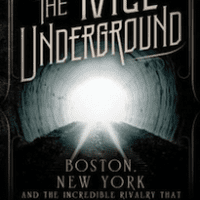“It’s better to wait for the Devil than to make roads down into hell.” — Christian Wolford, The Subterranean Railway
Summer is here. Ninety degree temps in most cities, north and south, humidity, ice cream vans swerving around neighborhood corners to get into a kid’s line of sight. In cities with subways, this is also known as the worst time of year to ride underground. Descending below the earth into a place that feels literally as hot as hell and waiting on a train in a tunnel where the air is so heated the oxygen feels baked and it hurts to inhale. When the train finally comes, you squeeze onto the train past the people who insist on crowding the door, and reach with slippery fingers for space on a pole. Your head is crammed next to a rider’s armpit who is dripping with sweat and potentially other body fluids because someone else five inches away is taking up an extra seat with a bag or obnoxiously spread legs. You might have a less than a two-mile distance to travel, but that ride could end up taking 45 minutes when the summer heat causes electrical problems belowground and your train car grinds to a halt. Ten minutes go by before someone on a crackly loudspeaker attempts to explain the delay. It doesn’t matter. You’re late. And then one of the many buskers starts singing reggae loudly at the back of the train. But this is how you and millions of other people across the country roll, so to speak, hurtling underground to other destinations, hoping to get there faster than you would on the street.
For those who are curious about this part of the modern mass transit experience, The Race Underground: Boston, New York and the Incredible Rivalry that Built America’s First Subway by Doug Most offers a compelling history. For those lucky enough to snag a seat on the train, it might help pass the time before the train starts moving again. Although the book was released in the spring, the summer subway season is a perfect time to dig into the past of the New York and Boston legacy subway systems, which comprise the No. 1 and No. 5 transit systems in the country, respectively. Because construction and delays.
Doug Most, deputy managing features editor at the Boston Globe, has written other city-based non-fiction tomes. He begins this story in 1867, painting the picture of horse-drawn carriages trying to navigate streets strewn with garbage and crowded with people, and quickly moves the narrative to the people whose innovation (and private funding) were critical to pushing forward the idea of safe, efficient, underground travel.

Though the subways in New York City and Boston both took some inspiration from the British, who had begun tunneling underground for transportation and commerce in the early 1820s, it was the Whitney family, first arriving in Massachusetts in 1635, that helped create the subway systems in those two cities. Most structures the book around Henry Whitney and William Whitney, both sons of the arriving family and first-generation Americans. Henry chose to stay in Boston, specifically the affluent nearby suburb of Brookline. There he purchased considerable tracts of land, especially near Beacon Avenue, which gave him a monopoly on railroads once the already-running streetcars in Boston ran out of room to expand tracks. William Whitney created a New York City legacy in more ways than one when his son Harry later married well-known artist and philanthropist Gertrude Vanderbilt, who founded the Whitney Museum of Art. William dabbled in politics and the stock market and later helped fund the New York Cable Railway Company in 1884, which acquired horsecar lines throughout Midtown in anticipation of owning lines that would stretch up to Harlem.
What is remarkable about the book, besides its expression of technology—the book necessarily devotes quite a bit of time to Thomas Edison and his protégés who were experimenting with electric railways—is its demonstration of how little the process of “progress” changes over time. Any time a person has a unique idea—such as Frank J. Sprague, an Edison mentee who perfected the electric motor and multiple-unit control system critical to keeping the tunnels free of pollution—the slow-moving wheels of bureaucracy, city government corruption, big money (or lack thereof), and backdoor deals seem to reappear to smack them down, slowing progress on a viable subway system for another 10 or 20 years. For perspective on how these issues are still relevant, one need only pick up a Chicago newspaper to read about riders’ frustrations with Blue Line construction or the ongoing struggle to extend Red Line service past South 95th Street. Any city with a mass transit system consistently deals with labor negotiations and safety issues. In 1895, Robert Meehan, foreman on the Boston Common’s subway stop, lost money on contractors when he refused to hire Italians due to personal bigotry and only hired Irish men, who were paid more.
It might have been interesting for Most to address how the environment and other hard-to-predict factors may change the future of the subway system, especially in those two cities. Both Boston and New York had to deal with weather-related shutdowns during the 2013 blizzard and Superstorm Sandy in 2012, respectively, and both are vulnerable based on their proximity to the Atlantic Ocean and its changing sea levels. The 19th century riders who were frightened about heat and fire below the surface might have been surprised to find that it was water and ice that shut down the trains almost 200 years later. Given what the book reveals about how long it can take to embrace change and progress, now is the time to start making plans for future railways that will serve millions of people daily. Most’s book details a technological accomplishment of several lifetimes. In that perspective, maybe the summer subway isn’t so bad after all.




